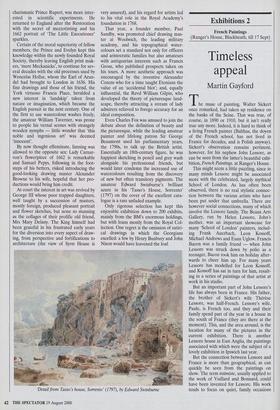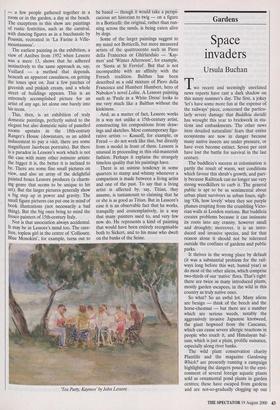Exhibitions 2
French Paintings (Ranger's House, Blackheath, till 17 Sept)
Timeless appeal
Martin Gayford
he muse of painting, Walter Sickert once remarked, had taken up residence on the banks of the Seine. That was true, of course, in 1890 or 1910, but it isn't really true any more. Indeed, it is hard to think of a living French painter (Balthus, the doyen of the French school, has not lived in France for decades, and is Polish anyway). Sickert's observation remains pertinent, however, for his nephew John Lessore, as can be seen from the latter's beautiful exhi- bition, French Paintings, at Ranger's House.
This might seem a little puzzling, since in many minds Lessore might be associated more with the celebrated, largely mythical School of London. As has often been observed, there is no real stylistic connec- tion between the various artists who have been put under that umbrella. There are however social connections, many of which involve the Lessore family. The Beaux Arts Gallery, run by Helen Lessore, John's mother, was an important showcase for many 'School of London' painters, includ- ing Frank Auerbach, Leon Kossoff, Michael Andrews and Euan Uglow. Francis Bacon was a family friend — when John Lessore was struck down by polio as a teenager, Bacon took him on holiday after- wards to cheer him up. For many years Lessore has modelled for Leon Kossoff, and Kossoff has sat in turn for him, result- ing in a series of paintings of that artist at work in his studio.
But an important part of John Lessore's life has always been in France. His father, the brother of Sickert's wife Therese Lessore, was half-French. Lessore's wife, Paule, is French too, and they and their family spend part of the year in a house in the south of France (they are there at the moment). This, and the area around, is the location for many of the pictures in the current exhibition. There is another Lessore house in East Anglia, the paintings associated with which were the subject of a lovely exhibition in Ipswich last year.
But the connection between Lessore and France is more than geographical, as can quickly be seen from the paintings on show. The term intimiste, usually applied to the work of Vuillard and Bonnard, could have been invented for Lessore. His work tends to focus on quiet, family occasions — a few people gathered together in a room or in the garden, a day at the beach. The exceptions in this show are paintings of rustic festivities, such as the carnival, with dancing figures as in a bacchanale by Poussin, recreated in `La Farine a Ville- moustaussou'.
The earliest painting in the exhibition, a view of Antibes from 1952 when Lessore was a mere 13, shows that he adhered instinctively to the same approach as, say, Vuillard — a method that depends, beneath an apparent casualness, on getting the tones spot on. Just a few patches of greenish and pinkish cream, and a whole street of buildings appears. This is an extremely accomplished picture for an artist of any age, let alone one barely into his teens.
This, then, is an exhibition of truly domestic paintings, perfectly suited to the elegant but also domestic suite of panelled rooms upstairs in the 18th-century Ranger's House (downstairs, as an added inducement to pay a visit, there are some magnificent Jacobean portraits). But there is a paradox in Lessore's work which is not the case with many other intimiste artists: the bigger it is, the better it is inclined to be. There are some fine small pictures on view, and also an array of the delightful painted boxes Lessore produces (a charm- ing genre that seems to be unique to his art). But the larger pictures generally show a big step up in power and gravity. The small figure pictures can put one in mind of book illustrations (not necessarily a bad thing). But the big ones bring to mind the fresco painters of 15th-century Italy.
Nor is that association always accidental. It may be in Lessore's mind too. The care- free, topless girl in the centre of 'Collioure, Blue Monokini', for example, turns out to be based — though it would take a perspi- cacious art historian to twig — on a figure in a Botticelli: the original, rather than run- ning across the sands, is being eaten alive by dogs.
Some of the larger paintings suggest to my mind not Botticelli, but more measured artists of the quattrocento such as Piero della Francesca or Ghirlandaio — 'Kay- mos' and 'Winter Afternoon', for example, or 'Siesta at St Ferreol'. But that is not incompatible with an affinity with the French tradition. Balthus has been described as a odd mixture of Piero della Francesca and Humbert Humbert, hero of Nabokov's novel Lolita. A Lessore painting such as 'Paule in a White Dress' looks to me very much like a Balthus without the kinkiness.
And, as a matter of fact, Lessore works in a way not unlike a 15th-century artist, constructing his compositions from draw- ings and sketches. Most contemporary figu- rative artists — Kossoff, for example, or Freud — do not work like that, but directly from a model in front of them. Lessore is unusual in proceeding in this old-masterish fashion. Perhaps it explains the strangely timeless quality that his paintings have.
There is an asinine tendency in some quarters to stamp and whinny whenever a comparison is made between a living artist and one of the past. To say that a living artist is affected by, say, Titian, they assume, is tantamount to claiming that he or she is as good as Titian. But in Lessore's case it is an observable fact that he works, tranquilly and contemplatively, in a way that many painters used to, and very few now do. He represents a kind of painting that would have been entirely recognisable both to Sickert, and to his muse who dwelt on the banks of the Seine.
Tea Party, Kaymos' by John Lessore



























































 Previous page
Previous page